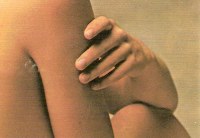Cramps by Kathy McCoy
|
||
 Most of the time Emily Young, a fifteenyear-old from Eugene, Oregon, feels terrific. She loves swimming, tennis, and partying and is always up for hanging out with her friends--except for the two or three days every month when she has severe menstrual cramps. Emily's cramps are so bad that they are accompanied by nausea and chills, and she usually misses at least one day of school a month. Her best friend tells her that it's all in her head, that if she had a more positive attitude (instead of dreading her period each month) she wouldn't have so much pain. But her mother, who had similar cramps when she was younger, tells her that the pain is part of being a woman and that there's nothing she can do but just live with it.
Both Emily's friend and her mother are wrong. The cause of her pain is not psychological, nor does she have to suffer every month. In recent years researchers have made important discoveries about the causes of-and cures for-menstrual cramps, which doctors call dysmenorrhea. As a result, no one has to live with bad cramps any longer.
There are two kinds of dysmenorrhea. Primary dysmenorrhea is what most teenagers experience. By far the more common of the two, it occurs most often in women in their teens and twenties. Secondary dysmenorrhea refers to pain that can come from a cyst, an undetected sexually transmitted disease, or same other physical disorder.
Up until about twenty years ago, no one was sure what caused primary dysmenorrhea. But in 1965 a researcher discovered the link between menstrual cramps and prostaglandins. These hormonelike substances, which stimulate the action of the body's involuntary muscles, are responsible for contractions of the uterus. Some contraction, or squeezing, of the uterus is necessary to expel the menstrual flow. But when too many prostaglandins are produced, the uterus contracts excessively, causing painful cramps. Often these contractions reduce the supply of blood and oxygen to the pelvic area, resulting in lower back pain as well. If these excess prostaglandins get into your bloodstream, they can make other involuntary muscles-such as the stomach and the intestines-contract more rapidly, causing nausea and diarrhea. Prostaglandin levels are highest during the first two days of menstruation, which is why cramps usually get lighter over the days that follow.
What can you do if you have painful periods? Try taking an antiprostaglandin medication. This type of drug inhibits the overproduction of prostaglandins, removing the major cause of cramps. Antiprostaglandins are available in both low-dosage, nonprescription form and in higher dosages, by prescription.
Experts suggest that you first try the over-the-counter varieties. One of these is aspirin. Studies have shown, however, that another drug, ibuprofen-the active ingredient in Advil, Nuprin, and Midol 200-is more effective in combating cramps and much less likely to cause the upset stomach sometimes associated with aspirin.
How well these drugs work will depend on when and how often you take them. Doctors suggest taking the medication at the very first sign of your period or when the cramps begin, then every four to six hours, as needed. If you wait until the cramps are severe, the drug won't be as helpful. If one brand isn't effective, try another before you give up on the nonprescription drugs. If none of the overthe-counter medications eases the pain, ask your doctor about the possibility of getting a prescription for one of the stronger antiprostaglandins.
It's possible that the antiprostaglandin drugs won't work for you at all. If so-and if your cramps occur at· times other than your period-you may have secondary dysmenorrhea. It's important in this case to see your doctor for a thorough checkup. Some of the most common causes of secondary dysmenorrhea are endometriosis, a condition in which pieces of uterine lining grow outside the uterus, and pelvic inflammatory disease. Both of these conditions can be painful and may threaten your future fertility, so early diagnosis and treatment are essential. Other causes of secondary dysmenorrhea, such as ovarian cysts, also need prompt medical attention.
Another method of treating severe cramps is to take birth control pills, because they suppress ovulation and may relieve pain in some women. Doctors are most likely to recommend this treatment for women who are allergic to aspirin or other antiprostaglandins. Strong painkillers, like Darvon, are usually a last choice these days, but they may be prescribed if a girl is allergic to antiprostaglandins and birth control pills are not advisable.
Besides medication, there are a number of natural remedies that ease cramps. Many women lind that their cramps are less severe when they have been exercising regularly and maintaining a healthy diet. Keeping lit can make you less susceptible to cramps over the long term.
More immediately, exercises like running, last walking, swimming, or cycling cause the body to release substances called endorphins, which are natural pain lighters. Exercise doesn't work for everyone, but if you enjoy being active and can talk yourself into a workout during the most painful days of your period, you may find it helps.
Meditation and relaxation exercises can also help ease the muscle tension that adds to menstrual discomfort. Try deep breathing, progressively relaxing your muscles from head to toe, or imagining yourself feeling peaceful and relaxed in a setting you especially enjoy. Try, too, to stay away from salty loods just before and during your period. You'lI be less likeIy to retain water and experience uncomfortable bloating.
If you suffer from menstrual pain, keep trying until you find a treatment that provides relief. You don't have to let cramps interfere with your life.
Source: Seventeen Magazine
|
Cramps
|
|